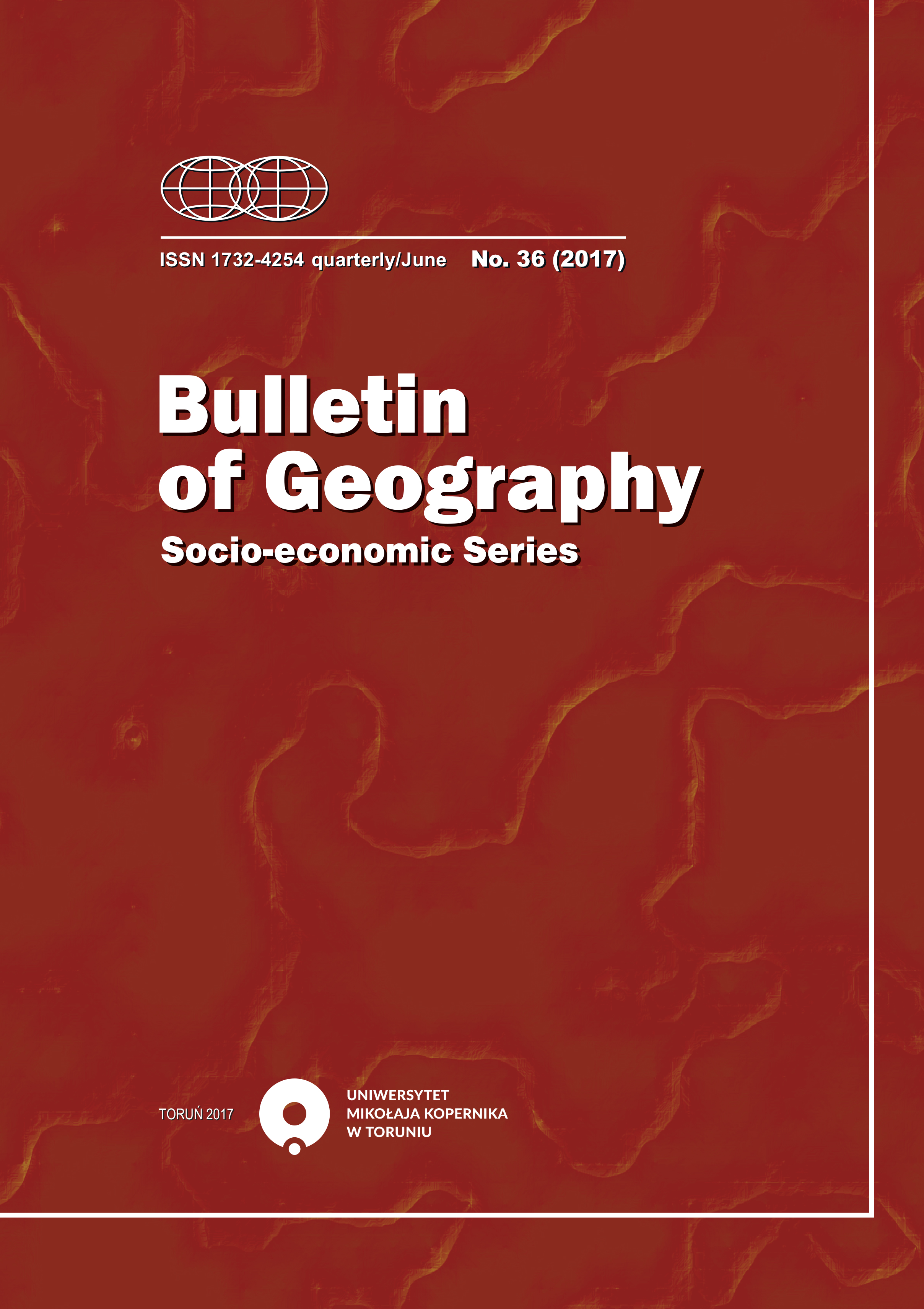Geography of FDI from Visegrad Countries in Russia
DOI:
https://doi.org/10.1515/bog-2017-0018Abstract
The article investigates the Russian place in outward FDI geography of the Visegrad countries. The role of the neighborhood effect is shown. With the help of the authors' special methodology for FDI calculations which overcomes deficiencies in the Bank of Russia's statistics, the distribution of the Visegrad group's FDI between Russian regions is studied. The authors demonstrate the presence of a hierarchical-wave model of spatial diffusion of FDI by investors in retail and banking. At the same time, it is found that Moscow and its surrounding dominate the recipient regions. It is also shown that Visegrad group investments in Russia are mostly made by enterprises which remove any political component. As a result, their FDI expansion to the Russian market is likely to continue as soon as the Russian economy returns to growth .References
Andreff, W., 2003: The newly emerging TNCs from economies in transition: a comparison with Third World outward FDI. In: Transnational Corporations, Vol. 12, Issue 2, pp. 73-118.
Bank of Russia, 2016a: Russian Federation: Inward Foreign Direct Investment Positions by Geographical Allocation in 2009-2015, available from: http://www.cbr.ru/Eng/statistics/credit_statistics/direct_investment/dir-inv_in_country_1_e.xlsx , DoA: 15 June 2016.
Bank of Russia, 2016b: Russian Federation: Outward Foreign Direct Investment Positions by Geographical Allocation in 2009-2015, available from: http://www.cbr.ru/Eng/statistics/credit_statistics/direct_investment/dir-inv_out_country_1_e.xlsx , DoA: 15 June 2016.
Cantner, U., Günther, J., Hassan S.S. and Jindra, B., 2013: Outward FDI from the Central and Eastern European Transition Economies – A Discrete Choice Analysis of Location Choice within the European Union. University Library of Munich, No. 51804, available from: https://core.ac.uk/download/files/432/18425326.pdf , DoA: 15 February 2016.
Gorynia, M., Nowak, J. and Wolniak, R., 2012: Emerging Profiles of Polish Outward Foreign Direct Investment. In: Journal of East-West Business, Vol. 18, Issue 2, pp. 132-156. DOI: 10.1080/10669868.2012.697982
Kaliszuk, E. and Wancio, A., 2013: Polish Multinationals: Expanding and seeking innovation abroad. Emerging Market Global Players Project. Report dated June 5, available from: http://ccsi.columbia.edu/files/2015/04/Poland_2013.pdf , DoA: 12 March 2016.
Kalotay, K., 2004: Outward FDI from Central and Eastern European Countries. In: Economics of Planning, Vol., 37, Issue, 2, pp. 141-172.
Kalotay, K., Elteto, A., Sass, M. and Csaba, W., 2014: Russian capital in the Visegrád countries. In: Centre for Economic and Regional Studies HAS Institute of World Economics Working Paper, No. 210, pp. 1-55.
Kuznetsov, A., 2008: Pryamye inostrannye investitsii: ‘effekt sosedstva’ (Foreign Direct Investment: Neighbourhood Effect – in Russian). In: Mirovaya Ekonomika i Mezhdunarodniye Otnosheniya, Issue 9, pp. 40-47.
Kuznetsov, A. and Chetverikova, A., 2007: Vostochnoevropeiskie strany ES: kuda idut ikh investitsii. In: Sovremennaya Evropa (East-European EU member states: where their investments go to – in Russian). In: Contemporary Europe, Issue 4, pp. 70-84.
Kuznetsov, A., Kvashnin, Y. and Gutnik A., 2013: Monitoring of Mutual Investments in the CIS. Report, No. 15, St. Petersburg: EDB Centre for Integration Studies.
Kuznetsova, O., Kuznetsov, A., Turovskiy, R. and Chetverikova, A., 2007: Investitsionnye strategii krupnogo biznesa i ekonomika regionov (Investment Strategies of Large Business and Economy of Regions. URSS, Moscow – in Russian), Moskva: URSS.
McGann, J., 2015: 2014 Global Go To Think Tank Index Report, Philadelphia: The University of Pennsylvania, available from: http://repository.upenn.edu/cgi/viewcontent.cgi?article=1008&context=think_tanks , DoA: 16 June 2016.
Milota, A., 2015: Vsegda yest’ kuda padat’ (It is always possible to find possibilities for decline – in Russian). In: New Kaliningrad, 3 December, available from: https://www.newkaliningrad.ru/news/economy/7638642-vsegda-est-kuda-padat-investory-polshi-zhdut-opredelyennosti-v-kaliningrade.html , DoA: 16 June 2016.
Ministry of Economic Development of the Russian Federation, 2013: Gosudarstvennaya programma Rossiiskoi Federatsii ‘Ekonomicheskoe razvitie i innovatsionnaya politika’ (State Program of the Russian Federation ‘Economic Development and innovation Policy’ – in Russian), available from: http://economy.gov.ru/minec/about/structure/depStrategy%20/doc20130408_01 , DoA: 17 March 2016.
Radlo, M-J. and Sass, M., 2012: Outward Foreign Direct Investments and Emerging Multinational Companies from Central and Eastern Europe. The Case of Visegrád Countries. In: Eastern European Economic, Vol. 50, Issue 2, pp. 5-21. DOI: 10.2753/EEE0012-8775500201?journalCode=meee20
Rangelova, R., 1999: Economic Growth in Transition CEESs: Implications for and of Modern Growth Theory. In: Economies in Transition and the Varieties of Capitalisms: Features, changes, Convergence. In: Dimitrov, M., Andreff, W. and Csaba, L. editors, European Association for Comparative Economic Studies. Institute of Economics at the Bulgarian Academy of Sciences. Proceedings of the 5th Biannual Conference of the EACES Varna, Bulgaria, 1998 September 10-12. Sofia: Gorex Press, pp. 99-123.
Rugraff, E., 2010: Strengths and weaknesses of the outward FDI paths of the Central European countries. In: Post-Communist Economics, Vol. 22, Issue 1, pp. 1-17. DOI: http://dx.doi.org/10.1080/14631370903525561
Sass, M. and Fifekova, M., 2011: Offshoring and Outsourcing Business Services to Central and Eastern Europe: Some Empirical and Conceptual Considerations. In: European Planning Studies, Vo. 19, Issue 9, pp. 1593-1609.
Sass, M. and Kovács, O., 2015: Hungarian Multinationals in 2013 – A Slow Recovery after the Crisis? Emerging Market Global Players Project. Report dated March 5, available from: http://ccsi.columbia.edu/files/2015/04/EMGP-Hungary-Report-2015-covering-2013-FINAL.pdf , DoA: 12 March 2016.
Schlunze, R.D., 1992: Spatial Diffusion of Japanese Firms in West Germany and West Berlin from 1955 to 1989. In: Geographical Review of Japan, Series B, Issue 1, pp. 32-56.
UNCTAD, 2016: World Investment Report 2016 – Investor Nationality: Policy Challenges, available from: http://unctad.org/en/PublicationsLibrary/wir2016_en.pdf , DoA: 22 June 2016.
World Bank, 2016: Ease of Doing Business in Russian Federation, available from: http://www.doingbusiness.org/data/exploreeconomies/russia , DoA: 17 March 2016.
Downloads
Published
How to Cite
Issue
Section
License
Title, logo and layout of journal Bulletin of Geography. Socio-economic Series are reserved trademarks of Bulletin of Geography. Socio-economic Series.Stats
Number of views and downloads: 411
Number of citations: 2



